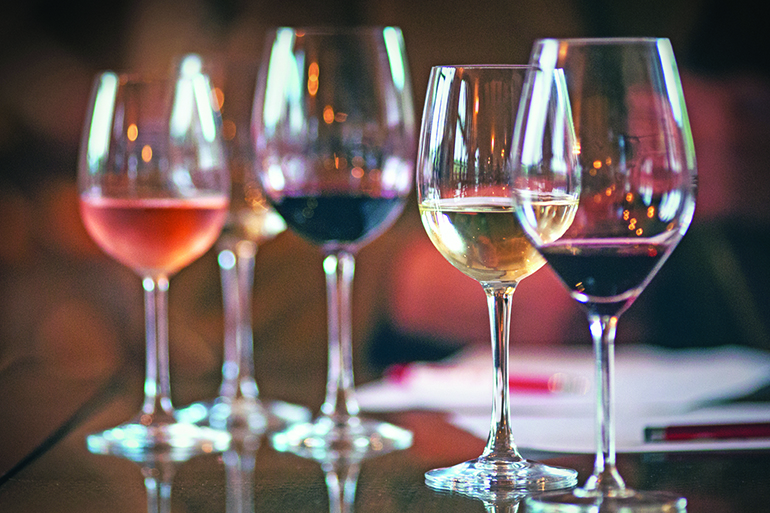Imbibing Guide: Why Wine Glass Size—and Shape—Matter

If you question whether a drinking vessel’s design affects your enjoyment of a given beverage, just think about the last time you took your sweet time enjoying a glass of wine.
No doubt the flavor of the wine opened up over time, warming and changing, likely becoming softer and sweeter on the tongue and possibly more nuanced. This is what it’s all about—oxidation and temperature. One can manipulate these factors through the choice of serving vessel.
Taste buds are distributed throughout the mouth, on the hard palate (roof of the mouth) and the soft palate, just before the throat, in addition to the tongue. Certain areas are most sensitive to the primary tastes—sweet, salty, sour, bitter and umami. So how glasses are shaped can lead to different taste buds being activated, directing the flow to the “sweet spot” at the tip of your tongue that’s particularly sensitive to sweetness and salt, for example.
Olfactory receptors in the human nose account for approximately 80% of what we experience as flavor! Most of this comes through gases passing from the mouth into the nasal passages during mastication. The rest comes through our taste buds and our sense of a beverage’s temperature and pungency or “sting.” Flavors in food are also affected by our sense of texture. To describe a wine as “chewy” refers to the textural quality of its pronounced tannins.
Probably the most radical difference between glasses is whether or not they are stemmed. To hold a glass of wine by its stem is to better retain its serving temperature. To hold the bowl of a glass in your hands warms the wine quickly, sending out more gases and volatile organic compounds. In the case of an older wine, in which you want to retain aromas and its fragile fruit, look for a narrower opening to retain those qualities and to lessen exposure to air.

Generally, you want whites to have less exposure to warming air and to stay cool. Bowls that are straighter on the sides can help them stay at a lower temperature. While a big red—a Burgundy, for example—can gloriously open up through a wide opening.
Rosés can be served in white wine glasses, but glasses made specifically for rosés have shorter bowls that are slightly tapered and sometimes have a flared rim. “The rim affects the way you sip,” Gabe Geller, a top, nationally known sommelier explains. “The flair helps direct the wine directly to the tip of the tongue.”
Or maybe it’s more about the look. We drink first with our eyes. Why are Champagne flutes long and narrow? To retain—and to show off—those fabulous bubbles!
Can a glass improve a terrible wine? No. But some wines that are not a pleasure to drink—provided they’re not corked—can be tasty when used in marinades. Others are best left to turn to tart vinegar. Intense wines—such as dessert wines and fortified wines—are intended to be enjoyed in relatively small amounts. Small flutes are used to send the sweet hit directly to the back of the mouth.
Many oenophiles prefer crystal to glass because its mineral content lends it structural strength, allowing the production of very thin vessels. This affords a closer connection to the wine—both as it flows into the mouth and the view of its color and viscosity or “legs.”
Does the relative roughness of the crystal surface create turbulence in the wine, which, in turn, causes more of the aromatic compounds to be released? Maybe, but regular glass seems to work just fine, as long as you use a clear, un-etched and uncut glass.
Can you just use a standard, stemmed goblet for all wine? Sure, but pay attention to the wine’s temperature before it goes into the glass. Rosé, though a popular summer beverage, should not be served ice cold! Reds are typically served around room temperature. Reds are generally more complex than whites as they’ve had more exposure to the grapes’ skins.
Geller agrees. “There’s no reason to think you’ll ever be judged by your stemware,” he says, “and you don’t have to be a professional sommelier to choose the right glass.”

And then there’s mead. The taste, nose, and mouthfeel differ greatly from one mead to another. Meads can be quite sweet, or savory.
Traditional vessels include horns, tankards and bowls called “mazers.” Though horns are naturally tempting, the modern vessel of choice for mead is a delicate wine glass with a mouth designed to help retain the nuanced flavors that concentrate in the top layer. The heavier flavor layers linger below.
You already have favored glasses for your mixed drinks and beer, right? An old fashioned glass, a martini glass, a beer stein…it might be time to get a selection of wine glasses.
Stacy is currently at work on The Hamptons Kitchen with co-author Hillary Davis. Due out in July, 2019. In it you’ll find Stacy’s suggested wine—and beer—pairings for over 100 foods.



